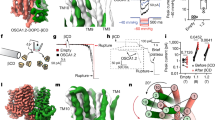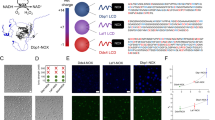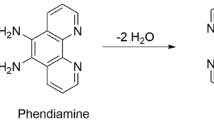Abstract
To appreciate fully the significance of the high-resolution crystal structure of the reaction-centre complex from the purple bacterium Rhodopseudomonas viridis1,2, there is increasing impetus to construct models to ascertain how the specific variables such as distance3–5, exothermicity6–9 and solvent10–11 control the rates of electron transfer through the integral membrane protein complex. Recently, we have determined the effect of a 4 Å change in distance (at fixed exothermicity, solvent and temperature) on the rates of photon-induced electron transfer for two porphyrin-quinone assemblies separated by rigid spacers3,4. From picosecond fluorescence lifetime measurements on zinc meso-phenyloctamethylporphyrin coupled to a benzoquinone moiety via one and two bicyclo[2.2.2]octyl spacers (10 and 14 Å, edge-to-edge), we deteremined that the rates of electron transfer are 1010 s−1 and ≤107s−1, respectively (the exothermicity, −ΔG = 1.0eV in acetonitrile at 25 °C). This result revealed that the porphyrin-quinone separated by a 10-Å spacer would be ideally suited, with regard to picosecond fluorescence techniques for a study of exothermicity effects at fixed distance and solvent. Here we report the fluorescence lifetimes of a homologous series of seven porphyrin-quinone molecules, each with differently substituted ben-zoquinones separated by an identical rigid phenylbicyclo[2.2.2]octane spacer (10 Å, edge-to-edge) which vary with respect to driving force for electron transfer from the first excited singlet state of the porphyrin. The key features of this series of molecules lie in the fact that the edge-to-edge distance is fixed and ΔG is tunable. Thus, the effect of exothermicity on electron transfer can be measured while avoiding major perturbations of the electronic structure.
This is a preview of subscription content, access via your institution
Access options
Subscribe to this journal
Receive 51 print issues and online access
$199.00 per year
only $3.90 per issue
Buy this article
- Purchase on Springer Link
- Instant access to full article PDF
Prices may be subject to local taxes which are calculated during checkout
Similar content being viewed by others
References
1. Deisenhofer, J., Epp, O., Miki, K., Huber, R. & Michel, H. Nature 318, 618–624 (1985). 2. Deisenhofer, J., Epp, O., Miki, K., Huber, R. & Michel, H. J. molec. Biol. 180,385–398 (1984). 3. Leland, B. A. et al. J. phys. Chem. 89, 5571–5573 (1985). 4. Joran, A. D., Leland, B. A., Geller, G. G., Hopfield, J. J. & Dervan, P. B. J. Am. chem. Soc. 106, 6090–6092 (1984). 5. Warman, J. M. et al. Nature 320, 615–616. (1986). 6. Miller, J. R., Calcaterra, L. T. & Close, G. L. J. Am. chem. Soc. 106, 3047–3049 (1984). 7. Wasielewski, M. R., Niemczyk, M. P., Svec, W. A. & Pewitt, E. B. J. Am. chem. Soc. 107, 1080–1082 (1985). 8. Irvine, M. P., Harrison, R. J., Beddard, G. S., Leighton, P. & Sanders, J. K. M. Chem. Phys. 104, 315–324 (1986). 9. Rehm, D. & Weller, A. Israel J. Chem. 8, 259–271 (1970). 10. Pasman, P., Mes, G. R, Koper, N. W. & Verhoeven, J. W. /. Am. chem. Soc. 107, 5839–5843 (1985). 11. Schmidt, J. A., Siemiarczuk, A. Weedon, A. C. & Bolton, J. R. /. Am. chem. Soc. 107 6112–6116 (1985). 12. Harris, D., Johnson, A. W. & Gaete–Holmes, R. Bioorg. Chem. 9, 63–70 (1980). 13. Lambert, W. R., Felker, P. M. & Zewail, A. H. J. chem. Phys. 81, 2217–2232 (1984); Felker, P. M. & Zewail, A. H. /. chem. Phys. 82, 2975–2993 (1985). 14. Marcus, R. A. /. chem. Phys. 24, 966–978 (1956). 15. Hopfield, J. Proc. natn. Acad. Sci. U.S.A. 71, 3640–3644 (1974). 16. Marcus, R. A. & Sutin, N. Biochem. biophys. Acta 811, 265–322 (1985). 17. Gunner, M. R., Robertson, P. E. & Dutton, P. L. J. phys. Chem. (in the press). 18. Jortner, J. J. chem. Phys 64, 4860–4867 (1976). 19. Jortner, J. J. Am. chem. Soc. 102, 6676–6686 (1980). 20. Buhks, E. & Jortner, J. FEBS Lett. 109, 117–120 (1980). 21. Hopfield, J. J. in Protein Structure: Molecular and Electronic Reactivity (eds Austin, R. H. et al.) (Springer, New York, in the press). 22. Ulstrup, J. & Jortner, J. /. chem. Phys. 63, 4358–4368 (1975). 23. Marcus, R. A. Discuss. Faraday Soc. 74, 7 (1982). 24. Anno, T. & Sado, A. Bull. chem. Soc. Japan 31, 734–739 (1958). 25. Baudet, M. J., Berthier, G. & Pullman, B. /. Mm. Phys. 54, 282–284 (1957). 26. S. M. Swingle, /. Am. chem. Soc. 76, 1409 (1954). 27. Bratoz, M. S. Besnamou, M. S. J. chim. Phys. 56, 555–562 (1959). 28. Higasi, K., Baba, H. & Rembaum, A. Quantum Organic Chemistry 242–246 (Interscience, New York, 1965).
Author information
Authors and Affiliations
Rights and permissions
About this article
Cite this article
Joran, A., Leland, B., Felker, P. et al. Effect of exothermicity on electron transfer rates in photosynthetic molecular models. Nature 327, 508–511 (1987). https://doi.org/10.1038/327508a0
Received:
Accepted:
Issue Date:
DOI: https://doi.org/10.1038/327508a0
Comments
By submitting a comment you agree to abide by our Terms and Community Guidelines. If you find something abusive or that does not comply with our terms or guidelines please flag it as inappropriate.



